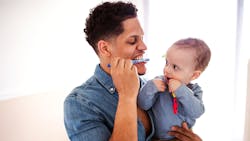4 tips to help parents win the brushing battle
Last August, I went to visit my brother’s family in New York City. My sister-in-law had been getting my nieces excited about my visit and had been talking me up because “Auntie Becca is very good at helping people clean their teeth!” One of the first nights I was there, I sat down with one of my nieces on my lap, her back toward me. “I got this,” I thought confidently. “She is going to love this.”
I put the toothbrush in her mouth and started to brush. Within seconds she closed her mouth and turned her head away with a very insightful complaint. “Too spicy!” she exclaimed. We laughed it off, but for the remainder of the encounter she would only let me access the facial surfaces of her anterior teeth, not letting me access her occlusal or lingual surfaces at all. She also complained that it hurt.
I felt a little embarrassed and defeated as I was falling asleep that night. My dental hygiene brain was spinning. There I was, a future dental professional, and I could not manage to use my skills to help my niece enjoy the brushing process. What went wrong? What went right? What could be done to make it better in the future?
That experience has impacted the advice I give to friends and patients. I have compiled a short list that can be helpful when teaching frustrated parents how to get their kids to have a better experience with brushing their teeth. In hygiene school we learned some tips to offer parents as we help them in their efforts to help their kids brush their teeth. So, some of these suggestions are “old news” to us but may be “new news” to parents who are not dental professionals.
1. Choose kid-flavored toothpaste
Many people do not understand that adult toothpaste is not the ideal option for young children simply because it is not appealing. In the video above, my niece immediately reacted to the taste of the toothpaste almost as soon as it was put in her mouth. The minty toothpaste that provides the “zing” effect that satisfies many adults is often overpowering to younger palates. Toothpaste developers take flavors for children’s toothpastes seriously because they are “important so as to encourage, rather than obstruct, the development of good oral care habits for life.”1 It is important to advise parents to purchase age-appropriate toothpaste for their young children.
Additionally, consider recommending that parents buy a few different flavors of toothpaste, for example, strawberry, bubblegum, and watermelon. Children feel empowered when they have options and the ability to make their own decisions. Remind parents that spending a few extra dollars on a variety of children’s toothpastes is a minimal expense when compared to the alternative expense of fillings.
2. Purchase soft or extra-soft children’s toothbrushes
Encourage parents to purchase soft or extra-soft toothbrushes for their children. Many stores have a limited selection, so you could also suggest that they go online to find different options. Brushing can be painful to children because of their growing jaws, sensitive gums, and erupting teeth. Reducing the “ouch” factor of brushing by recommending soft toothbrushes will help kids feel more at ease about the brushing process.
Another easy adjustment that can be made is to lighten the lateral pressure that children and/or parents use when they are brushing. Even the softest bristles can feel like needles if they are pressed up against the gums too hard. Remember that plaque is a biofilm and it does not take much to remove it. Tell parents to let the bristles do the work. Keeping kids comfortable will help them be more cooperative.
3. Allow the child to choose his/her toothbrush
Allowing children to choose which toothbrush they want is another excellent way to get kids more enthusiastic about brushing. Pediatric toothbrushes are intentionally designed to have thicker handles for easier grasping, smaller heads for more comfortable access, and they have bright colors and recognizable characters. This makes the toothbrush look more appealing. Help skeptical parents see that while these brushes may be a little more expensive, their appeal factor is worth the investment. Allowing little ones to choose between two or three options gives them a sense of ownership and will hopefully help them feel more enthusiastic and excited about brushing.
4. Find a way to make it fun
Kids love games and, depending on their age, they are often enthusiastic about doing activities where they can bond with others—especially their parents. Unfortunately, children associate toothbrushing with bedtime. And we all know how most kids feel about bedtime.
Making it fun can be difficult. What works like a charm one day can be an epic fail the next day. But here are a few fun suggestions that may be helpful to parents.
- Brush their teeth before they get in the bath or change into their pj’s to try to avoid the negative association of toothbrushing and bedtime.
- Sit on the ground and brush your teeth with them. Little games like “Simon Says” or “Copy Cat” could catch the child’s interest.
- Turn on their favorite song for them to dance to while they are brushing.
Always remember...
After giving parents each of the four suggestions, make sure to give them encouragement. Parents and caregivers face many challenges and sometimes the battle of helping children brush their teeth feels too overwhelming to handle. Encourage them to keep their chin up and to keep trying because “tooth brushing habits which are learnt during early years of life [are] deeply ingrained in the child’s mind and this may [lead] to adoption of good oral hygiene methods in later life.”2
References
1. Stovell AG, Newton BM, Lynch RJM. Important considerations in the development of toothpaste formulations for children. Int Dent J. 2013 Dec;63(2):57-63. https://onlinelibrary.wiley.com/doi/full/10.1111/idj.12083.
2. Pullishery F, Panchmal GS, Shenoy R. Parental attitudes and tooth brushing habits in preschool children in Mangalore, Karnataka: A cross-sectional study. Int J Clin Pediatr Dent. 2013 Sep-Dec;6(3):156-160. https://www.ncbi.nlm.nih.gov/pmc/articles/PMC4086598/.
Rebecca “Becca” Neilson, BS, grew up in Provo, Utah. She graduated from Brigham Young University in 2014 with a BS in biology. She is happily married and lives in Elkhart, Indiana. Becca’s long-time hobby is arranging flowers and she currently works as a florist. She is excited to graduate and receive her licensure in May of 2020. Becca thrives on interpersonal relationships and finds satisfaction in helping others learn. You can reach her at [email protected].
About the Author

Rebecca Neilson, BS, RDH
Rebecca “Becca” Neilson, BS, RDH, grew up in Provo, Utah. She graduated from Brigham Young University in 2014 with a bachelor of science in biology, and Indiana University South Bend in 2020 with a bachelor of science in dental hygiene. She is happily married and lives in Elkhart, Indiana. Becca’s long-time hobby is arranging flowers, and she currently works as a florist. She thrives on interpersonal relationships and finds satisfaction in helping others learn. You can reach her at [email protected].
Updated August 26, 2020
